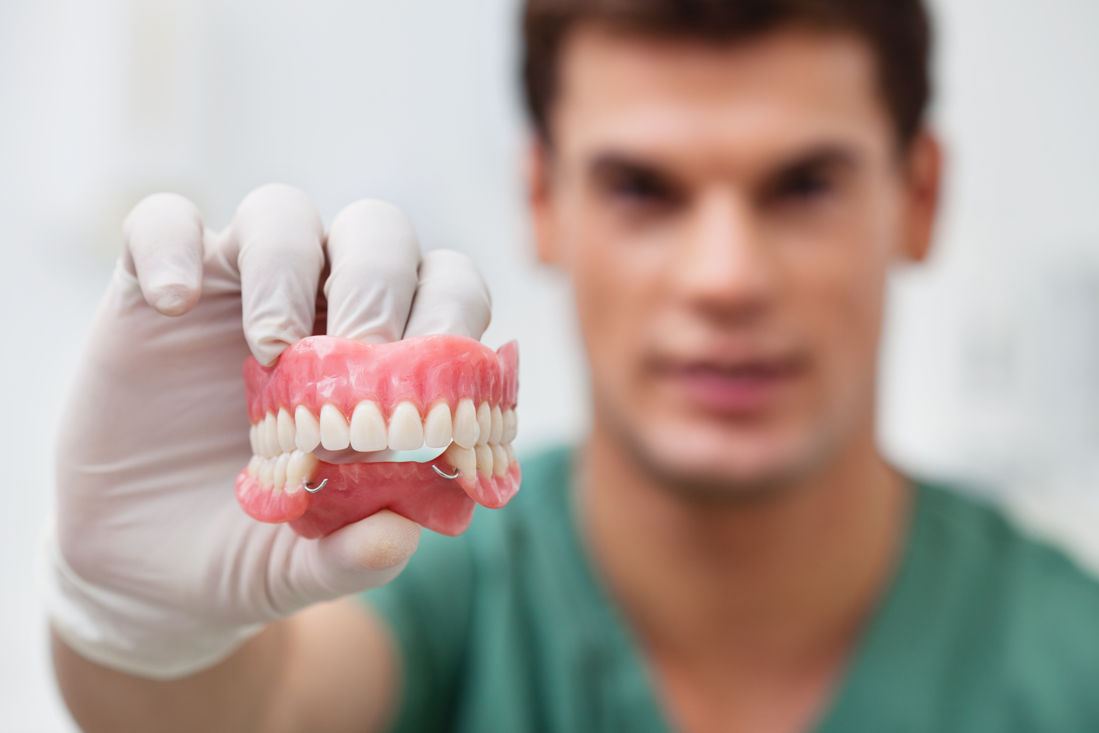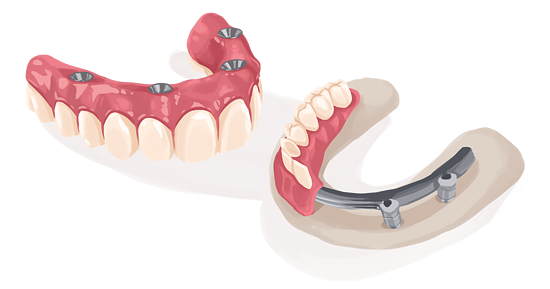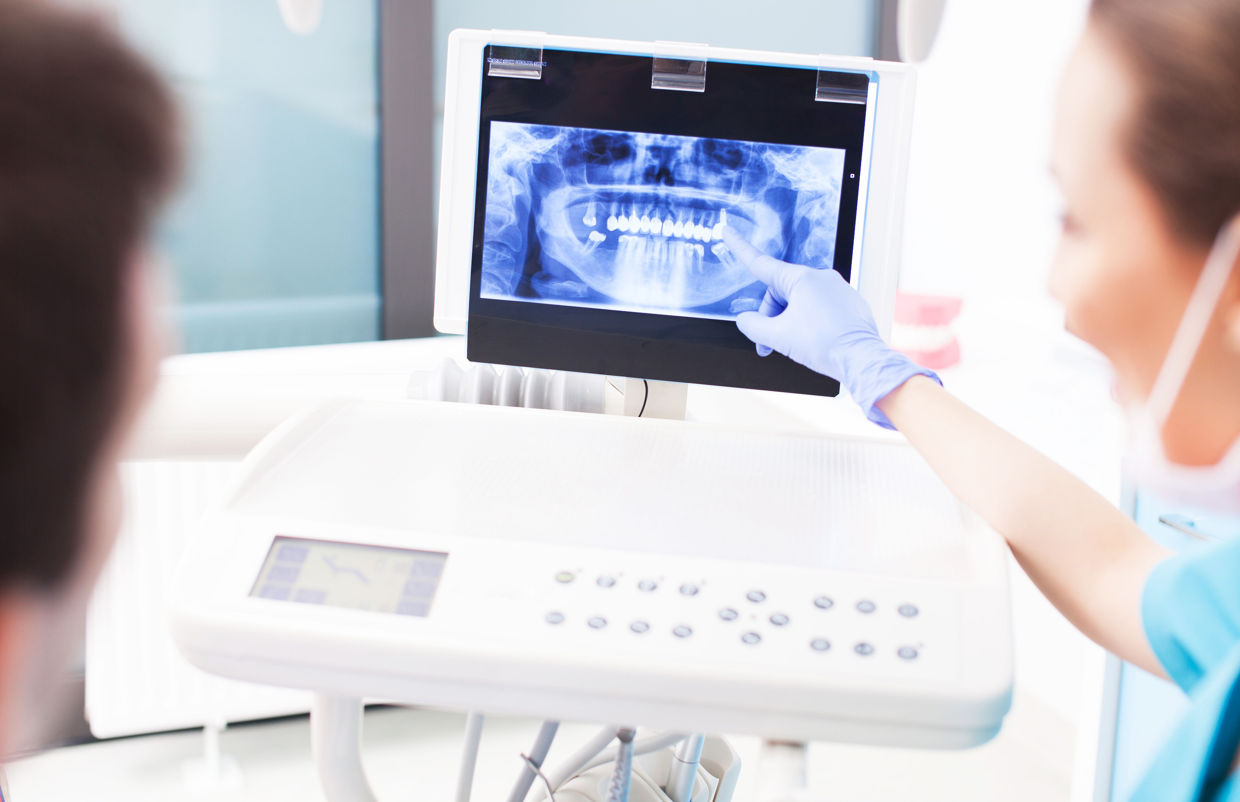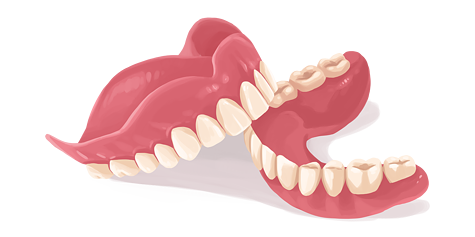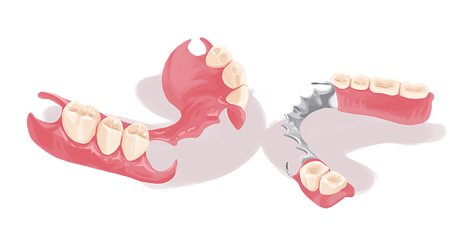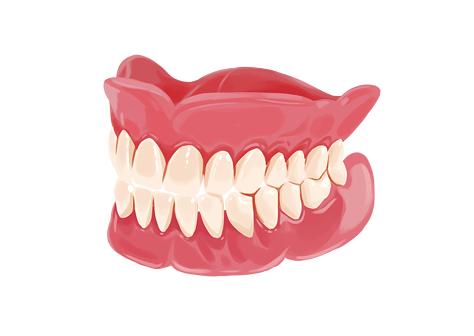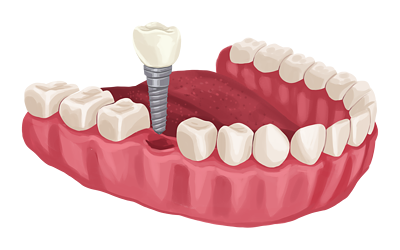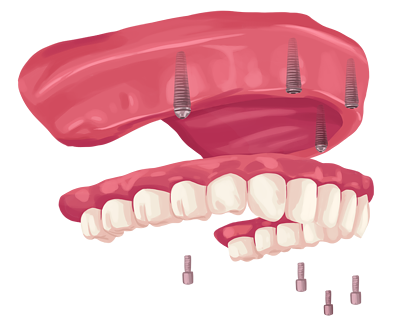Why Do Dentures Need a Reline?
Over time, your jaw may change and dentures may not fit as well as they originally did. This can create a lot of issues with your mouth. So what is the solution?
In this guide, we explore the key to resolving denture fit problems, shedding light on the process of how to reline dentures for a comfortable, what they do, types of relines and snug fit ensuring optimal oral health and functionality.
Changing bone
When teeth are first removed, it leaves holes in the bone where the roots of the teeth once were. These holes, called extraction sockets, fill in as healing occurs.
The bone of the jaw gradually reshapes over time while healing. Most changes happen in the first four to six months after tooth removal.
Small changes can continue to occur for years more. Tooth roots normally stimulate bone and keep it dense and strong.
Once teeth are removed, the bone is absorbed by your body. Jaws with no teeth can become smaller and more fragile over time.
What do relines do?
There is no way to predict how your jaws will reshape as the bone heals. If you need teeth removed, dentures are usually made to fit your jaw as it is now.
As your jaws change over time, the dentures will become loose. Relines are made to fill in the space left under your denture as bone is absorbed.
A good fit is needed with dentures to make them stable. It also prevents sore spots, fungal infections, and gum tissue overgrowth.
Dentures may need to be relined several times when you first get them. Even if you have been without teeth for years, relines may be needed as changes occur. To find out more about dentures, click here.
Types of relines
There are several kinds of relines available. Which type you should get depends on your individual needs.
Temporary reline
A temporary reline is usually done when significant changes are expected. This is a soft, rubber-like material your dentist can do in his office.
Temporary relines are often placed soon after tooth extractions with an immediate denture. They are also used when the gums are irritated or swollen from poorly fitting dentures.
These relines don’t last long and will need to be replaced with another more permanent reline once the jaws have had time to heal.
Soft reline
A soft reline is used when a patient gets frequent sore spots or wants a more cushioned feel to their denture. It is soft like a temporary reline but is made to be much tougher and longer lasting.
Although they last longer than a temporary, soft relines don’t last forever. Expect to replace a soft reline every one to two years.
Hard reline
A hard reline is made from essentially the same material as the body of a denture. It is a hard acrylic and will last for many years.
A hard reline is done if the patient is tolerating dentures well. They aren’t as cushioning as a soft reline but their long life and durability make them a good choice for most people.
How often should you reline denture?
You should reline a denture when it begins to feel loose or previous relines begin to wear out. Wearing a denture that does not fit snuggly can create many common problems, including sore places, infections, or puffy, overgrown gums.
Expect a temporary reline to wear out every few weeks and a soft reline about every one to two years. A hard reline done at a dental laboratory will last for years, but you still may need to replace it due to bone changes.
If bone changes are substantial or the teeth become too worn, it may be time to get a whole new denture.
How to reline denture?
Relines are best done at your dentist’s office, but an at-home kit is an option if cost or access to a dentist is an issue.
Professional denture reline
Both kind of professional denture reline, soft and hard, are done differently.
- Your denture is roughened on the inside and an adhesive is placed on the acrylic.
- The soft reline material is placed into the denture and it is seated in your mouth to cure.
- Once it has stiffened, the denture is removed and trimmed.
- An impression of your jaw is taken inside your denture.
- The whole denture is then sent off to a dental laboratory to have the durable reline material placed.
- Usually, the denture can be returned to the patient the next day.
DIY denture reline kit
If cost or ability to get to a dentist are an issue, there is a do-it-yourself kit available at many drug stores. These work similarly to the soft relines mentioned above.
Be advised that these kits do not last very long and must be done correctly. If the denture is not seated precisely, you may create more problems than you solve.
Denture reline cost
Many people get dentures thinking it is the last dental treatment they will need. They are unaware than dentures need relines, eventual replacement, and may have other additional costs involved.
A soft reline done in the dental office only takes one visit and may cost $300-$400. A laboratory reline means being without your denture for one night and costs around $500, but will generally last much longer.
| Reline type |
Cost |
| Soft reline |
$300-$400 |
| Hard reline |
$500 |
Can you avoid denture reline?
Most relines are needed because the bone of the jaw is no longer stimulated by teeth. That is why it is worth to consider other teeth replacement options.
Dental implants are seen as a better way to replace teeth. They are great anchors for making stable teeth replacements. They also provide stimulation to the jaw to prevent bone loss.
Implants can be used to create dentures that snap into place. While more stable, these dentures do still come in and out of the mouth. They also need regular maintenance on the attachment points and will have to be replaced every five years or so, much like traditional dentures.
An alternative is the G4 by Mike Golpa. This revolutionary treatment option features permanent bridges supported by just four dental implants. They are beautiful, stay in like natural teeth, and can usually be placed in just one 24 hour period!
And since the implants help maintain the bone, the only reline that is normally needed occurs six months after any teeth are removed. This helps prevent food from getting trapped under the bridges.
Once complete, G4 restorations only require normal cleanings and checkups to maintain them for a lifetime!
Types of Dental Bridges: Pros, Cons and Cost
If you’re looking into getting a dental bridge, you may already know about all the different kinds. Whether you do or not, this article will take you through an overview of each, their pros and cons, and what they cost.
Ready to learn about the types of dental bridges available?
So which bridge will you cross?
1 – Traditional dental bridge
A traditional dental bridge is the most common type of bridge people get. They have as few as one tooth and attach to the prosthesis. The whole contraption attaches to your surrounding natural teeth via abutments, which are cemented to the natural teeth.
So if you have natural teeth on both sides of the gap that needs a fake tooth, you can get a traditional bridge.
A traditional bridge usually costs between $2,000 and $5,000, which includes the prosthesis with a crown per abutment tooth.
- Very popular and reliable dental prosthesis
- Works well in most patient cases
- Comparatively affordable
- The dentist will need to remove the enamel of the supporting teeth to place the crowns over top of them
- The removed enamel will never grow back, so once you get a traditional bridge, you’ll always have to have a bridge
2 – Cantilever dental bridge
Cantilever bridges are similar to traditional bridges, the main difference being that the prosthesis is supported by just one abutment on just one side of the mouth.
So if you have just one natural tooth next to the gap left by a missing tooth, you can get a cantilever bridge.
But like traditional bridges, the dentist will need to remove enamel to prepare the supporting tooth.
A cantilever bridge costs between $2,000 and $5,000, which includes the prosthesis with a crown per abutment tooth.
- Works if only one tooth is next to the gap left by a missing tooth
- Most affordable type of dental bridge
- The dentist will need to remove the enamel of the supporting tooth to place the crown over top of them
- Because it attaches to just one tooth, it can more easily lead to a fractured tooth or loose crown
3 – Maryland dental bridge
If you’re looking for a more conservative option to a traditional bridge, you can go with a Maryland dental bridge. It is a good choice for replacing the missing front tooth.
This bridge is held in place by a framework (two wings), usually made of porcelain or metal. The framework is attached to the back of the two teeth next to the gap. But there is the one condition – these teeth must be healthy, with no cavity.
A Maryland bridge can cost between $1,500 and $2,500, including the prosthesis with the framework/wings that attaches to the abutment teeth.
- Because the framework is bonded to the teeth, the dentist doesn’t need to remove enamel
- A more conservative option to a traditional bridge
- May not be as strong as a traditional bridge
- The framework may get in the way of your bite or gums
4 – Implant-supported dental bridge
The last option we’ll cover is an implant-support bridge. This is a good option for people who have more than just one tooth missing. Instead of using surrounding teeth as support, this bridge is supported by dental implants.
Usually there’s one implant per missing tooth, but if that’s not possible, it can use two implant-supported crowns.
An implant-supported bridge can cost anywhere from $5,000 to $6,000 for two implants covering 3-4 teeth.
- Feels very sturdy because it’s supported by implants
- Many times does not require removing any enamel
- Can choose a removable bridge or a fixed bridge
- Requires two surgeries — one to place the implants and the one to place the bridge
- Can be very expensive, the most expensive bridge on this list
Is it possible to get a bridge for full mouth replacement?
Here’s the thing: if you have multiple missing teeth and you want a truly permanent solution, these options may not be exactly what you need.
The best type of bridge for you may very well be the G4 implant procedure. It’s an upgraded and improved version of the All-On-4 solution. Dr. Golpa is the brains behind the G4 solution and has since done the procedure over 5,000 times.
G4 offers a dental bridge supported by four implants and it’s placed in just one day. So it’s both durable, reliable, and done quickly. It’s a full-mouth replacement done in a day that will last many, many more days.
Common Denture Problems and How to Deal with Them?
Dentures and problems just go together. As good as a set of fake teeth are, they, like anything else, is going to have issues.
So what are the most common denture issues? And how can you deal with them?
In this guide, we’ll learn about the common dentures problems how to solve them, offering insights into prevalent challenges and providing practical solutions to ensure a seamless denture-wearing experience.
What are the most common denture problems?
If you’ve ever experienced one of these common denture problems, you’re not alone. These are the most common issues denture wearers experience.
Dentures slipping
Sometimes you may feel your dentures slipping or shifting. Usually it happens when you smile, laugh, cough, eat, or talk.
A quick fix in the moment of slippage is to bite down (which repositions them) and swallow. We’ll talk about a long-term solution below.
Gums & mouth soreness
If you’re dentures become loose, they can start to rub against the gums or inside or your mouth. This can lead to inflammation, which, if not treated promptly, infection.
To much saliva
Dentures are a new object in your mouth, so it’s completely normal for your mouth to produce more saliva. Eventually, they’ll adjust, but at first you may find you have extra spit hanging around.
Difficulty eating & speaking
If you’re an experienced denture wearer, you probably know that it takes practice to learn how to eat and talk with dentures. Over time, you’ll learn how to hold the dentures in place with the muscles in your mouth.
When it comes to speaking with new dentures, they may feel unnatural and can get in the way of how you’re used to talking.
Also, food can sometimes get stuck under your dentures, which is annoying.
Plus, you may experience less of a taste with food and drinks because your palate is covered by the dentures. Many people don’t realize the palate actually has taste sensors.
Bad breath
If your dentures aren’t sealed properly, food particles and drink residue can get up underneath and sit there. That, if not cleaned in time, leads to bad breath.
Not cleaning your dentures frequently or correctly can lead to bad breath, even if food particles don’t get stuck to them.
Bone loss
Over time, your gums and jawbone deteriorate. So after a while, you may find your dentures no longer fit — this could be because you’ve experienced bone loss.
Jaw joint changes
If your jawbone atrophies, this can affect the jaw joint. And, unfortunately, the jawbone cannot form new bone, so once it’s worn away, it’s gone.
And if your jaw joint changes, that may affect the way your dentures fit your mouth.
How to solve denture problems?
Okay, now onto the solutions to the above problems. These fixes can help solve multiple issues you may be experiencing.
Eat soft food
If you’re experiencing trouble eating, you can try eating softer foods.
Avoid hard or sticky foods — that will just make things more difficult. Taking smaller bites and chewing slower can help as well as using both sides of your mouth when you chew.
The longer you have your dentures, the easier it will get to eat. It’s just a matter of getting use to them.
Use denture adhesive
Using denture adhesive is a great way to hold your dentures in place — most people use it because holding the dentures in with your mouth muscles alone can be too difficult.
This can help solve slippage as well as bad breath because it’s less likely that food particles will get up under the dentures.
Consider denture reline
A denture reline is when your dentist adds to lining to the surface that sits against your gums. They’ll basically reshape your dentures to fit better.
You can get a soft reline or a hard reline. The former uses a liquid polymer that’s layered on the denture to provide a sort of cushion. The latter uses a harder material and is usually a more permanent solution.
Either way, a reline can help with uncomfortable or slipping dentures.
Take care of your dentures
You must have the same level of care for your dentures that you’d have for your natural teeth. But it can be tricky knowing what to do and not do, so here are some tips for taking care of your dentures:
- Don’t sleep with your dentures unless your dentist advises it
- Be careful when you’re handling your dentures — if you drop them, they could break
- Clean your dentures every day soaking them in a denture cleaner overnight, cleaning them every morning before you put them in with a denture brush
- Clean your mouth every day, massaging your gums, the roof of your mouth, and tongue with a soft-bristled brush
- Don’t use toothpicks as those can damage your dentures
Practice pronunciation
Right after you get dentures, it will probably feel weird and be difficult to speak. But just be patient. Try speaking slowly and work on your pronunciation.
It may feel silly at first, but it can be very helpful. It will make you more familiar with how to talk with your new set of teeth.
Choose G4 by Mike Golpa
A much more convenient and permanent option to dentures is the G4 implant solution.
It’s basically the All-On-4 procedure but better and more long-lasting. Dr. Golpa and the team have performed over 5,000 of this special G4 procedure, so we’ve honed it until it’s the best it possibly can be.
For more info, contact us to see if you might be a candidate.
What Are Most Common Causes of Dental Implant Failure?
Nothing is perfect. Even if the most experience doctors use the most proven methods, complications can still happen.
And dental implant failures show us this is true in the dental world too. So if this happens to you, what do you do?
In this insightful exploration, we delve into the complexities surrounding dental implant setbacks, shedding light on the causes of dental implants failure and offering guidance on how to navigate through such instances with informed decisions.
Signs of dental implant failure
The most common sign that a dental implant has failed is mobility, if the implant is moving. Even if it’s just slight (i.e. micro-movements), it could have failed and will only move more and more as time goes on. If you notice movement at all, it’s time to speak with your dentist.
Other indications that an implant has failed are pain and swelling happening over two weeks after the surgery. You could also experience infection, but not always.
If your dentist notices signs of dental implant failure, they’ll most likely order an X-ray of your mouth. In the case of a failed implant, the X-ray will show them bone loss around the implant.
Why do dental implants fail?
There are many reasons dental implants can fail. When it comes to short-term implant failures, most of the time it’s because the bone did not successfully integrate with the bone (i.e. osseointegration).
This can happen because of:
- diabetes,
- low bone density,
- poor oral hygiene,
- gum disease,
- or if the patient continued smoking after getting the implant.
Another possibility is that the body simply rejected the implant as a foreign body, although this is rare.
As far as long-term implant failure, the most common cause is peri-implantitis, which is a chronic infection in the gums that affects the implant’s supporting bone. If this happens, the symptoms show as:
- pain,
- discomfort,
- pus excretion,
- or bleeding of the gums.
Other long-term failure causations can include an acute injury to the site, broken screws, loosening of the abutment, or a fractured restoration. All of these issues can be correct though.
Overall, dental implants have a failure rate of about 5%, so it’s unlikely that you’ll experience an implant failure.
Dental implant failure treatment
Taking care of a dental implant failure depends on what caused it. What you should do contact your dentist, then they will talk with you about the best treatment options.
For example, if the implant is infected, you can try to clean the area regularly until you can visit your dentist. However, if the implant is failing because it’s damaged, your dentist may need to get a bone graft to add more support to the implant.
In severe cases of failure, the entire implant may need to be replaced, which is basically like starting from scratch.
Can failed dental implant be replaced?
Yes, a failed dental implant can be replaced. However, replacement implants don’t usually do so well.
If you need to get your implant removed, you have a tough choice ahead of you. You can get some sort of removable prosthesis, but that’s not the best option according to most professionals.
If you had just one implant fail and you also have nearby natural teeth that can be anchors, you can possibly get a fixed partial denture.
But most patients choose to simply get another dental implant. The problem is the success rate ranges between about 70% and 90%, much lower than the success rate of 95% for the initial implant procedure.
And because of this, many dentists charge extra to replace implants. It’s too risky, they say.
But with Dr. Golpa and his team, they will replace your G4 dental implant at no additional cost including any necessary corrective procedures (within the warranty timeframe).
Other doctors may consider implant replacement an exception, but for us it’s actually routine.
Prevention of teeth implants failure
The best defense is a good offense, as they say. In other words, prevention is the best treatment.
Oral hygiene
Before you notice any symptoms of failure, make sure you’re taking good care of your implants by keeping a good oral hygiene routine. Brush and floss and use antibacterial mouthwash, as you would with your natural teeth.
Proper diet
You may also need to adjust what you eat and drink too. There are bone-healthy foods like milk, eggs, and fish that you can incorporate into your diet.
And it’s probably better to avoid really hard foods or candy, at least until your dentist says it’s okay.
Regular check-ups
You’ll also need to have regular visits with your dentist to make sure everything is looking good, preferably every six months.
Experienced dentist
The quality of the dentist and surgeon is crucial — it’s probably the most important factor in avoiding an implant failure.
Fortunately, the doctors on Dr. Golpa’s team are some of the most experienced at this, specifically placing G4 implants, which is a new and improved version of the traditional All-On-4 procedure.
Will I Have Dental Implant Pain After Surgery?
When you look at what goes on during a dental implant procedure, everybody’s first thought is, “Will it hurt?” And that’s a fair question.
Will you have dental implant pain? If so, how long will it last? Is it an indication that something’s wrong? The fear of pain can often overshadow the excitement of restoring a confident smile.
Addressing concerns about dental implant pain is crucial in demystifying the process and ensuring patients make informed decisions about their oral health.
Do dental implants hurt?
For most patients, there is no little to no pain.
Many people who get implants go back to work the same day. Usually, your dentist will recommend taking an over-the-counter pain killer a few times a day and you may experience some soreness.
But for the most part, dental implants will not be very painful.
Teeth extraction
A tooth extraction is when the dentist must remove one or more teeth because of damage or decay. They may also remove a tooth if that spot needs to be used for one of the implant anchors.
Bone grafting
Bone grafting is when the dentist takes bone from somewhere else in your body or uses a synthetic bone to add more of a foundation for the implant.
If this is necessary, it may take several months for the jaw to grow enough new bone in order to support an implant.
Surgery
Any time surgery is needed, the dentist will use anesthesia. You may either be sedated or just receive a powerful local anesthesia and stay awake during the procedure.
Because of the invention of anesthesia, you won’t feel anything during the surgery and the discomfort afterwards will be minimal.
How long does pain last after dental implant surgery?
When it comes to pain after getting dental implants, how long will it last?
Well, immediately after the surgery and in the following days, you may experience swelling, bleeding, and bruising. These symptoms typically hang around for about 48 hours before they start to diminish.
If you have dental implant pain after 5 days, that’s okay. But if the symptoms persist longer than 10 days, you should contact your dentist for a follow-up.
If you’re experiencing dental implant pain after 3 months, you may be experiencing early dental implant failure.
An implant can fail due to many reasons, like:
- gum disease,
- rheumatoid arthritis,
- diabetes,
- an inexperienced surgeon,
- or if you continue to smoke after getting the implant.
If you have dental implant pain years later, that’s what we’d call a late dental implant failure.
This can happen because of:
- nerve damage,
- if your body rejects the implant as a foreign body,
- if the implant protrudes into the sinus cavity,
- or if you experience an acute injury to the area of the implant.
Some indications of a failed implant, on top of the pain, include infection at the implant site, micro-movement of the implant, or having an allergic reaction.
Some other symptoms to watch out for include:
- trouble chewing
- inflammation of the gums
- gum recession
- swelling that doesn’t go down
However, only 5-10% of dental implants fail, so it is a rare occurrence.
How to reduce dental implant procedure pain?
Here are some general tips for reducing pain in the first few days after surgery:
- Apply ice over the swollen areas.
- Use warm water mixed with a half teaspoon of salt — don’t swish or gargle, just let it sit in your mouth for a bit.
- If the bleeding is not being subdued by just gauze, take a tea bag (black tea), wet it, and use it on the wound like you would gauze — the tannic acid helps speed up the clotting process.
- Avoid hot foods for the first few days as heat opens up the blood vessels, which will lead to more bleeding.
- Feel free to eat ice cream! The soft texture is gentle on the wound and the coldness of it will help the swelling go down.
- Rest a lot.
Find an experienced dentist
If you’re looking to have minimal post-op pain, the best thing to do is to do pre-op research. By finding the most experienced dental professional you can afford, you’re lessening the likelihood of severe pain or even implant failure.
For example, G4 dentists who work with Dr. Golpa are some of the most experienced in the country. In fact, the whole G4 dental implant procedure is much faster, more reliable, and the recovery period is drastically shorter than with traditional implants.
Whatever type of implant operation you get, make sure you follow the surgeon’s instructions to the letter, which will include pain killers, dietary restrictions, and specific oral hygiene methods. They know what they’re talking about, so it’s best to listen to them.
Dental Implant Process: What You Need to Know?
The dental implant procedure is a big deal. You’re getting metal screwed into your jawbone and a new set of fake teeth placed in your mouth. It’s no surprise you’re looking to find out as much info about it as possible.
This article is tailored to be your comprehensive guide, unveiling the nuances of the dental implant process step-by-step providing you with the comprehensive insights you need before embarking on this transformative journey.
Are you a candidate for a teeth implant?
Dental implants are for people who are missing multiple teeth or are suffering from tooth decay.
Here’s a complete list of situations when you may very well be a good candidate for a teeth implant:
- If you’re missing multiple teeth
- If your jawbone is fully developed
- If you have enough bone to securely fuse with the implants
- If you have generally good oral health
- If you don’t have health problems that could jeopardize bone healing
- If you’re not able or not willing to wear dentures
- If speaking is too difficult
- If you’re willing to commit several months for the entire implant process
- If you don’t smoke tobacco or use tobacco products
Dental implant process step-by-step
Taking into consideration all of the stages and how long each could last, the whole dental implant procedure can take up to two years or longer.
Here’s a dental implant process step-by-step guide through the whole thing.
-
Initial consultation
The first thing you’ll do is meet with the dentist for the initial consultation. First, they’ll do a dental exam (which may include an X-ray and/or teeth impressions) to get a good idea of what they’ll be working with. Next, your dentist will come up with a treatment plan that includes the procedure steps, the timeframe for all of it, and what recovery will look like. If they think a bone graft is necessary, they’ll discuss that with you too.
-
Bone grafting
If you do need a bone graft, it could take 4-12 months after the graft before your jaw is ready and healed enough for the implants.
-
Dental implant placement
The next stage is the placement of the implants, which is a metal screw that’s inserted into your jaw bone. This is the anchor on which the whole prosthesis will sit. Placing the implants can take a couple hours, but you’ll be asleep the whole time.
-
Healing collar placement
After they place the implants, it can take up to five months for your lower jawbone to heal and seven months for the upper jawbone to heal. Once your bone is healed and has fused with the implants, you’ll get something called a healing collar. You may also need a temporary crown. The healing collar, a piece of round metal, goes on top of the implant and allows the gum tissue heal properly, keeping them from growing over the implant. The collar stays on for 10-14 days.
-
Abutment placement
Once your tissue is healed, the dental professional will remove the healing collar and place the abutment. This is the part that screws into the implant and on which will attach the crown. They’ll probably give you a temporary crown to wear for about 4-6 weeks while your custom-fit permanent crown is being made.
-
Crown placement
The last step in this process is to place the crown, which is the part that people will see, the part that looks like a real tooth. They will screw it onto the abutment and cement it in place.
Wondering how long does dental implant procedure take?
Taking into consideration all of the stages and how long each could last, the whole dental implant procedure can take up to two years or longer.
What to expect after dental implant surgery?
As with any oral surgery, you’ll most likely experience pain, swelling, maybe some bruising, and minimal bleeding.
First days after surgery
Directly after the surgery, your dentist will send you home with some instructions for the following 72 hours, including how to manage the symptoms. If the symptoms persist for a long time, speak with your dentist.
The following days
Following the surgery, you’ll want to treat your new teeth like you would natural teeth.
Go to your dentist on a regular basis, brush 2-3 times a day, floss, rinse with non-alcoholic mouthwash, don’t smoke cigarettes, or drink lots of alcohol. The implants are literally implanted into your bone, so they’re not going anywhere.
During your regular checkups, your dentist will also get X-rays of your mouth. What they’re looking for is how the implant, abutment, and crown are working well together.
Possible complications
There are some possible complications you should be aware of, like failed implant, infection, nerve damage, and sinus damage. But if you go to a reliable dentist, the likelihood of these things happening is less. Implants have an overall success rate of about 95%.
If everything goes well and you continue to take care of your implants as you would natural teeth, they can last as long as 25 years or longer.
Can the implant procedure be done better?
After meeting with you to prepare for the surgery, our team along with Dr. Golpa can place the implants and bridge in one visit.
We’ve improved upon the All-On-4 implant procedure and nearly perfected it, making it possible to get everything done in one visit. We use the best materials possible and make all customizations in-house.
Another key element when working with us is communication. We ensure you’re informed during every step of the process and do everything possible to make your experience as comfy and stress-free as we possibly can.
How to Take Care of Dentures?
If you have dentures, you know they’re your teeth. And that’s why you should treat them like you’d treat your natural teeth. You’d take really good care of them, right?
In this post, we’ll tell you pretty much everything you need to know about caring for your dentures to ensure they stay in optimal condition. From daily cleaning routines to expert tips, we’ve got everything covered on how to take care of dentures.
Dentures care instructions
In order to keep your dentures in good condition, therefore giving you the best experience possible, it’s important to know how to take care for them.
Your dentist will usually send you home with care instructions for your dentures, but here’s the general overview just in case.
How to remove dentures?
To remove your dentures, first stand over the sink and lay a towel inside the sink — in case they slip out of your hands, they’re less likely to break or get dirty.
After they’re out of your mouth, run water over them to get rid of any food left behind. As you handle them, be gentle, making sure you don’t bend them or break any of the plastic clasps.
How to clean dentures?
You’ll need to brush your dentures every single day. To do so, remove your dentures and brush them carefully with a soft-bristled toothbrush and a non-abrasive denture cleanser. If you use adhesive to hold your dentures in, make sure you brush the grooves that attach to your gums.
You can also soak your dentures in a denture cleaning solution overnight. You may want to double-check with your dentist about if, when, and how to soak your dentures.
Before you place the dentures back in your mouth, rinse them thoroughly with water.
Should you kept dentures in water overnight?
It is true that your dentures need to stay moist at all times in order to fit properly.
Typically, it’s a good idea to soak your dentures overnight, either in room-temperature water or a denture cleaning solution. Do not use hot water as that could warp your dentures.
But just to be safe, you should check with your dentist about how to soak your dentures overnight.
Dentures adjustment & repair
When it comes to keeping your dentures in good condition, the most important thing is to regularly visit your dentist for checkups. This way, they can perform any adjustments or repairs necessary.
And if any part of your dentures ha broken, chipped off, or malformed, you need to visit your dentist right away. These are your teeth, you need them to eat and talk and you don’t want to go very long in discomfort.
Take care of your mouth & gums
Even if you have dentures, you can’t forget about your gums. You have to take care of those dentures too.
So whenever you remove your dentures to clean or soak them, also brush your gums with a soft-bristled toothbrush or massage them a washcloth. You should also rinse your mouth before putting your dentures back in.
It’s also important to eat a well-balanced diet — your mouth and gums benefit from eating healthy.
Find a better option
After reading all of this, you may feel like caring for dentures is a big hassle. And you’d be right.
If you need new teeth, a much better option is G4 by Golpa. The G4 implant solution takes the All-On-4 procedure and massively improves upon it, giving you a permanent bridge made of durable titanium.
Plus, you clean them like natural teeth, so there’s no need to remove dentures, clean them, soak them, brush your mouth, then put them back in your mouth. In just one visit, you can have a brand new set of teeth thanks to the G4 procedure.
Where Can I Get Affordable Dentures?
If you suffer from constant tooth problems, you may be considering dentures. Dentures are a great way to replace missing teeth and get back a beautiful smile!
Even the cheapest dentures still cost $300-$600 when you pay full price. This will likely get you a plastic set of teeth. These tend to wear down quickly and break easily. They may not fit well, might need frequent relining, and need to be replaced every few years.
Avoid online companies that offer at home denture kits for a very low price. It is simply a scam. There is no way to get all the information the dentist needs by mail. Don’t ever have a denture made without visiting an actual dental professional.
All told, cheap dentures may end up costing a lot in the long run. Explore where can you get affordable dentures implants to make an informed decision for your dental health.
Choose affordable dentures, not cheap
Affordable is not the same as cheap, however. You can get a set of quality made dentures at a price you can manage in your monthly budget.
Investing in a nice set of acrylic dentures with durable teeth will cost from $1000-$3000 per arch. These cost more in the beginning but fit better and last longer. Specially customized dentures may run $4000 or more per set.
For those on a tight budget, prices like this may still seem out of reach. There are ways to make dentures more affordable, however.
#1: Travel abroad
One popular option is dental tourism. Countries like Mexico and Thailand offer great dental care for a lot less money than in the US.
Many people choose this route because they also get the chance to travel. Even so, there are several things to consider before packing your bags.
With the cost of travel, lodging, and food, you may end up paying more than you would in the states. But if you enjoy your trip, it may be worth it!
Another thing to think about is the quality of care. There are great dentists in other countries, but there are also doctors that cut corners to save money. You should thoroughly research who you are seeing before hopping on a plane.
#2: Find good dental insurance
Having good dental insurance can greatly reduce the price of dentures. There are many insurance plans available. Coverage can vary widely, so be sure the plan fits your needs.
Normally, dental insurance helps cover both removing teeth and replacing them. They don’t pay for everything, though.
Most dental insurances have a yearly maximum of $1000-$2000. Anything over this amount will come out of your pocket.
Most dental offices now offer in house or third-party financing. This helps cover the rest with a low monthly payment. Some even offer a cash discount if you pay your part in full.
#3: Consider dental savings plans
Dental savings plans offer big discounts on dental treatment at select providers. They can be used along with insurance or instead of insurance.
There are usually no limits or deductibles like traditional dental insurance. Signing up requires agreeing to a yearly subscription fee, but the price is usually low and the savings can be worthwhile.
#4: Visit dental schools
Having your dental work done by a student may concern some people. It is actually a great way to save significant cash. Every step of treatment has to be approved by a teaching dentist, so you’re going to get quality work done.
Prices at dental schools are often half of what they are at a private practice dentist. Treatment does tend to take a lot longer since every step has to be checked and graded.
#5: Use government program
Here are some government programs that can help you save on dentures.
Medicare
Medicare is government-sponsored insurance coverage. It is offered to seniors or those with disabilities.
Medicare does not have specific dental coverage. It does often cover dental extractions and other some other procedures though. Having your tooth removal surgeries covered can significantly reduce the overall price of treatment.
You can also find certain Medicare Advantage or Medicare Part C add-on plans. These offer dental coverage at additional costs. These plans are sold through private insurance companies and cover procedures beyond what is offered by Medicare alone.
Medicaid
Medicaid coverage, on the other hand, is income based and may vary from state to state. Some do offer help with dental treatment, including dentures.
Contact your state Medicaid office to find out what dental coverage is offered. If you need help with your coverage, call the Centers for Medicare and Medicaid Services (CMS) at 1-800-MEDICARE (633-4227).
PACE
Depending on your situation, another government program that may help is called the Program of All-inclusive Care for the Elderly (or PACE).
PACE is run jointly by Medicare and Medicaid. It focuses on independent living for seniors and avoiding long term nursing home care as long as possible.
#6: Check charity organizations
There are numerous charity organizations that offer help to those in need of dental services.
Dental Lifeline Network (DLN) is a national charitable organization. Their mission is to improve the oral health of people with disabilities or who are elderly and have no other way to get help. They have over 15,000 volunteer dentists nationwide.
The Oral Health America charity has a program for seniors called the Wisdom Tooth Project. It is tailored to older adults and their caregivers to connect them with care.
Another great resource is the United Way. With nearly 1800 locations around the world, the United Way helps connect those in need with various services including healthcare.
#7: Choose equally (or even more) affordable alternative
Even the most well-made dentures should be repaired, relined, and/or replaced every five to seven years. The teeth eventually wear down flat and become difficult to chew with, the body of the denture is likely to fracture or break over time, and the jaw bone changes over time. So dentures can end up being much more expensive than you expect.
There is an alternative to dentures, however, that is permanent, provides more chewing ability, and maintains the bone of the jaw. The G4 Implant Solution by Golpa uses 4-6 dental implants on each jaw with a permanent fixed bridge attached. They look, feel, and work like your natural teeth.
Implants stimulate the bone like natural tooth roots. That means your jaw does not waste away over time. The teeth are permanently attached as well. No more taking teeth out to put in a cup at night.
Best of all, they last a lifetime. While more expensive on the front end, you get value from not having to constantly replace dentures.
You also have the confidence of a permanently fixed smile. This may far outweigh the investment.
How Much Do Dentures Cost? G4 By Golpa
Dentures may seem like they cost a lot. That said, they are usually the cheapest way to replace a full mouth of teeth.
The total price of dentures can vary greatly, however. So can the quality of what you get!
Let’s take a look at how much you should expect to pay and other things you should be aware of.
Let’s delve into the details of how much do dentures cost to gain insights into the expenses and considerations associated with denture investments.
Dentures cost factors
Not all dentures are created equal. Here are some of the factors that can affect the cost of dentures.
Material
The least expensive economy dentures are made from a brittle, pink plastic. The teeth are the same material, but white. These denture teeth wear down quickly with use. The body of the denture tends to crack easily as well. They also may not fit as well as a higher quality denture.
You may pay less on the front end, but expect to have to replace economy dentures in a short time. Usually, they need to be replaced every couple of years.
A higher quality denture will have an acrylic body with special teeth made from acrylic or porcelain. These dentures are much stronger, look more natural, and tend to last for 5-7 years on average.
Dentures type
If you haven’t lost all your teeth, you may want a partial denture. These replace only missing teeth and lock on to the teeth you have remaining. Just like complete dentures, partial dentures can vary in quality and price.
The cheapest economy partial will be made from pink plastic. It will have pieces of bent wire sticking out that wrap around teeth. These tend to be thicker and heavier to prevent breaking.
A better made partial will have a thin metal framework. Cast metal clasps will custom fit to your teeth. Where visible, the metal is covered with pink acrylic and special wear resistant teeth.
There is also a new style of partials made from a special acrylic that flexes slightly. This gives the strength of high-quality partials without the metal framework. The nice thing is that the clasps are the same color as the gums. This makes them less noticeable in the mouth.
Location & specialist
Keep in mind, the cost of dentures can greatly vary depending on the location where you get your dentures and specialist you work with.
That’s why it’s super important to do your research before letting a dental professional do work on your teeth.
The average cost of dentures
The quality and needs of each patient will determine the total cost of a denture. Let’s break down what you may expect to pay for each kind.
Full dentures cost
The economy denture mentioned above will likely run $300-$600 per arch (meaning top or bottom).
Again, it’s less on the front end, but expect to replace these types of dentures in a short time. Replace them a few times and you could have paid for a longer lasting, better looking and fitting denture.
Investing in a nicer set of acrylic dentures with long-lasting teeth will cost from $1000-$3000 each. Certain custom made dentures can run $4000 or more per arch.
| Denture option |
Cost |
| Economy |
$300-$600 per arch |
| Economy plus |
$1000-$3000 per arch |
| Custom-made |
over $4000 per arch |
Partial dentures cost
Economy partials cost about the same as economy dentures. Expect to be charged $300-$600 per arch.
They come with the same issues as economy dentures as well, with the addition of wire clasps that often need adjusting.
Metal-framework partials cost around $900-$2000 each but are much more comfortable and durable.
Because they attach to remaining teeth, they are much more stable and functional as well.
| Partials option |
Cost |
| Economy |
$300-$600 |
| Metal-framework |
$900-$2000 |
Immediate dentures cost
Often there are teeth that need to be removed before you can make a denture. It can take several months for the bone to heal and reshape where the teeth once were.
You can choose to wait until the bone is completely healed, but most people don’t want to go without teeth for that long. As an alternative, dentists often offer immediate dentures.
Immediate dentures are normally more expensive than traditional ones. They may cost $1500-$3200 per arch. Also, add on the cost of any extractions and any bone surgeries necessary.
Extractions generally cost $75-$150 per tooth for non-surgical or $200-$400 per tooth for surgical extractions.
| Immediate dentures |
Cost |
| Arch of teeth |
$1500-$3200 |
| Non-surgical extraction |
$75-$150 |
| Surgical extraction |
$200-$400 |
Denture implants cost (snap-in & permanent)
Since complete dentures just rest directly on the gums, they tend to move around when you eat and talk.
Even the best fitting complete denture is only held in place by suction. The ability to chew is much less than if you had teeth anchored to bone. To overcome this issue, you may consider an implant denture.
Implant dentures snap on to four to six dental implants which are attached to the bone of your jaw. This creates a much more stable set of teeth with greatly improved chewing ability.
Each snap-on implant denture itself may cost $4000-$6000 (per arch), but the larger expense comes from the implants. A set of dental implants may cost as much as $20,000-$50,000, depending on several factors.
These snap on dentures are still taken out during each night, much like conventional dentures. They also have to be replaced every 5-7 years.
| Implant dentures option |
Cost |
| Snap-in |
$24,000-$515,000 per arch |
| Fixed |
$30,000-$100,000 per arch |
Other costs related to dentures
When people are looking for dentures, they often only look at the initial cost. There are other factors that should be accounted for, however.
Denture reline & repair
If you have no teeth, your bone tends to change and shrink over time. This can create situations where dentures no longer fit.
To overcome this you may need to have your denture relined. This means adding to the acrylic inside the denture to make it fit again.
Even with the best-made dentures, expect a reline every few years. A hard reline on a complete denture may cost $250-$500. If the denture is cracked or broken, a simple repair may run $100-$250.
If the crack is large, it may have to have all the acrylic replaced. This is called a rebase and may cost $400-$750.
Implant-supported restorations do not generally require relines, however. The implants help stimulate and maintain bone. In addition, these types of dentures have increased stability because they attach to the implants.
Economy denture lifetime
If you choose to get an economy denture, expect them to only last a couple of years. The soft plastic teeth wear down quickly and cannot be replaced. Flat teeth are very difficult to chew with.
Economy dentures are also often brittle and prone to break. A repair on an economy denture may cost as much as a new one.
| Associated procedures |
Cost |
| Denture reline (hard) |
$250-$500 |
| Simple repair |
$100-$250 |
| Denture rebase (acrylic) |
$400-$750 |
What is the most cost-effective option?
When deciding on what is best for your health and for your smile, there are many things to consider.
Conventional dentures tend to be the least expensive treatment initially. There are further costs that arise from repairs, relines, and replacements, however.
Additionally, conventional dentures don’t work, look, or feel like your natural teeth. Even the best dentures have much less chewing ability than the real thing. They also come in and out of your mouth and have to be replaced eventually.
When it comes to value for your dollar, the G4 Implant Solution by Golpa may be the best treatment available. These fixed bridges are the next best thing to having your natural teeth again! They look incredible, function like real teeth, and can last a lifetime.
G4 Implant Centers are located across the US. Schedule a phone consultation today to learn more!
How Much Do Full Mouth Dental Implants Cost?
Dental implants are considered the top of the line treatment for the replacement of missing teeth. No treatment option is closer to having your natural teeth.
For many patients, however, the cost may seem out of range. There are options for making dental implants more affordable, however!
Lets delve into the details of full mouth dental implants cost as we explore the expenses and affordable alternatives for achieving a complete and natural smile.
What is the average cost of full mouth dental implants?
The total cost of dental implants may vary widely. It depends on the patient and their individual needs. Other necessary procedures like sinus lift surgery or bone grafting may also add to the cost.
Single tooth dental implant cost
A single implant without the need for other procedures will probably run around $1500-$2500. The crown that is needed to go on top of the implant can cost from $1000-$3000, depending on the type needed.
A fixed bridge across multiple implants can be expensive. You need to know how many implants are needed and how many teeth will be replaced. Add those to get the total cost.
Sometimes further procedures are needed to prepare the bone for the implant. Those come with costs of their own that must be added in.
If you are simply replacing a single tooth, an implant makes a lot of sense. The cost of a single implant and a crown is roughly the same cost as doing a three-crown bridge.
With a bridge, the teeth on either side of the missing tooth are ground down. This makes room for a crown on each with a fake tooth connected between them. So a minimum of three crowns is needed to replace one tooth. Two potentially healthy teeth are cut down in the process.
| Single implant |
Cost |
| Implant placement |
$1,500-$2,500 |
| Dental crown |
$1,000-$3,000 |
Cost of full mouth dental implants
As you can see, replacing a full mouth of teeth with individual implants could be very expensive. Fortunately, that is rarely necessary. There are procedures that can replace an entire arch (top or bottom) of teeth with only 4-6 implants.
If you’re looking to replace your full arch with dental implants, you have a few options.
- Implant-supported dentures (AKA snap-on dentures): very stable option, you remove them at night in order to soak them while you sleep. Total cost for a top and bottom denture can be $12,000-$25,000.
- AO4: permanently attaches a fixed bridge over 4 implants, giving you a very natural look. This is called All-On-4 and is a big improvement over implant supported dentures. Total cost is between $50,000-$100,000 for a full mouth.
- G4 Dental Implant Solution: a more economical alternative and performed exclusively at Golpa Implant Centers. Total price for implants and restorations at a Golpa center may be as little as $11,700 per arch with Medicare (or $23,400 for top and bottom). Those without insurance can expect full mouth costs to begin at $36,500 and go to as much as $52,500 for the most complex cases.
| Type of restoration |
Cost |
| Implant-supported dentures |
$12,000-$25,000 |
| G4 by Mike Golpa |
$36,500 (with Medicare price starts at $13,750) |
The big advantage of G4 implants by Golpa is that replacement of teeth, start to finish, can happen in just one day (one 24 hour period).
Does insurance cover full mouth dental implants?
Some dental insurances help pay for implants, but most do not. The majority of dental insurances only pay towards the least expensive option, which in this case would be extractions and conventional dentures.
It is doubtful that even this least expensive option would be completely covered. Dentures fall into a category that insurers call “major”. Major procedures are ordinarily covered at 50%, and only up to the yearly maximum payout amount.
In most dental insurances, that yearly maximum is only $1000-$2000. You’ll probably max that out quickly and the rest will be out of pocket.
Medical insurance can often be used if dental health conditions might be affecting overall health. As mentioned above, filing on Medicare may help bring the cost of treatment down by over $6,000!
Medicare will only pay on procedures that they deem medically necessary, however. Tooth extractions may be medically necessary, but unfortunately, replacing teeth is not seen as a necessity.
What are my payment options for full mouth dental implants?
Few people can sit down and simply write a check for a procedure like the ones we have been discussing. Cash discounts often apply if you can, but for everyone else, there are payment arrangements available.
Golpa Implant Centers offers short term in-house financing and longer term financing through third-party lenders. For those that qualify, these lenders offer no-interest loans and extended payment terms with lower payments.
GreenSky Patient Solutions
GreenSky Patient Solutions and Lending Club are both companies that work with you to find an affordable monthly payment amount.
HSAs
Healthcare Savings Accounts are a great way to pay for your treatment. They are usually tax-free when used towards a qualifying medical expense. You should always check with your tax advisor to make sure the treatment you will be receiving will qualify.
If funds are used towards a non-qualifying treatment, you could be taxed at your income level plus a 20% penalty if you are under age 65.
IRAs
Many patients use Individual Retirement Account funds to pay for care. Normally, taking money from an IRA before turning 59 is not recommended due to the 10 percent withdrawal penalty.
The exception is if you have medical expenses for the year that would be deductible if you itemize your deductions. In this case, you can exempt that portion of the early IRA distribution from the penalty.
Are full mouth dental implants worth the money?
Some patients wonder why full mouth dental implants cost as much as they do. Surely those little bits of metal don’t cost that much, right?
Honestly, you’re right.
The cost covers so much more than just the implants, however. Included in the prices above are x-rays, consultations, surgical procedures, medications, the implants, custom milled titanium frameworks, hand-crafted dental bridges, and more.
Treatment is performed by a doctor that has trained for decades to be able to do what they do, assisted by a team of knowledgeable staff.
The restorations are created overnight while you sleep by a team of laboratory technicians using state of the art equipment and materials. The amount of knowledge, technology, and skill that it takes to do all that is amazing.
But it is a lot of money. And it’s completely normal to think that way: It’s a big investment. That’s the truth of it, though. But:
It’s an investment in yourself!
In your future. In your ability to chew and eat and talk and smile.
Being able to smile confidently has amazing benefits for your mental health. And having teeth and being able to properly chew may add as much as a decade to your life. How much is that worth to you?
If you are ready to invest in your health, or even if you just want to learn more, contact us. We’d be happy to discuss if the G4 Implant Solution is right for you.

